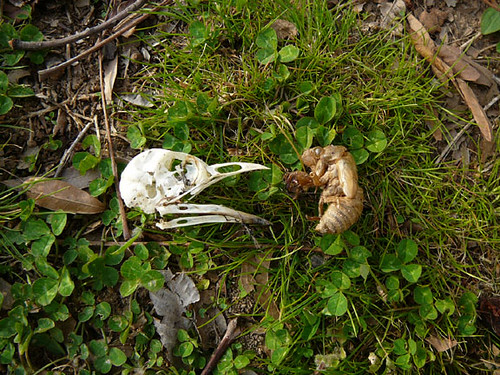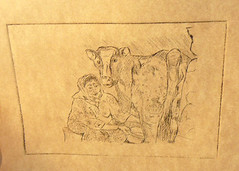
I'm not sure what the moral of the story is, but I found these two things outside today. And somehow they seemed to go together.

Seed potatoes. I know potatoes grow underground but I didn't realize "seed potatoes" existed and could be purchased by the pound out of wooden barrels. But now I got some and they are hopefully doing their thing out in the dirt. I did use legit yukon gold seed potatoes and also some red potatoes from the grocery store that grew eyes. We'll see if this potato experiment results in any clear conclusions on potato culture.
I got two old tires from my dad, to use as a potato-planting area. Thanks to T.K. and folks at the Y.L. for giving me the idea. I also used some plastic garden edging to create another area, because once I cut the potatoes I had too many to fit in the tire space. I'm trying really hard not to crowd plants, because I'm still having trouble coming to terms with the idea of thinning plants. I guess that's really the way you grow healthy plants, but I don't actually know how to do it. And it seems like a waste. But I'm just being sentimental, I guess.
On the topic of printing (with a hodgepodge of links)
In other news, this weekend I attended a dry point workshop at Gallery 5 put on by a local org called Art on Wheels. It was fun and the people were very nice. And I probably asked too many questions, but that seems to be my way.
I brought this photo as a reference from which to make the image.

This is one of my favorite photos from Bosnia. This lady was a neighbor of the people I was staying with and she was very excited to show me her milking station (located in a sort of stone room under a barn) and also a horse and a manure field. She was extremely enthusiastic.
So, what did I learn about dry point? Well, like all other printmaking techniques I've attempted so far, this one is also relatively complicated, messy and time consuming.
First we scratch our image (which will print in reverse) on a plate. Traditionally it would be metal, but we used plastic, which enabled tracing from a photo.

Then there's this whole long step where you apply and then rub off ink. You rub it off with a stiff cheesecloth called a tarlatan. I like that word. On a side note, I just read that tutus used to be made out of tarlatan until that was replaced with tulle.
Anyway, then place the rubbed off ink plate on the press, over which you place a dampened sheet of the paper, and then you run it through. Turning the press wheel took a lot more physical gusto than I was prepared for. At any rate, if you don't totally screw it up, your print will be ready on the other end of the press.

(paper isn't really that color, my camera is just pretending it is).
So, how do I feel about drypoint vs. screenprinting? Well, for one the way we did this there wasn't any talk of using more than black ink, and my great downfall in screen printing is failure to follow rules and register inks properly. So in that way, drypoint was less taxing on my brain. But then again, screen printing can be done without owning a press and overall it is less tiring as far as arms and wrists and hands go. (And that's always one of my issues).
So, I was just reading that drypoint is part of the intaglio family. I'm not quite sure I can remember the differences in each type of printing. But here's some discussion that explains the "dry" in drypoint referring to no acid being involved. In addition, I don't know how to get myself to pronounce things like intaglio (pronounced in-TAL-yo, IPA: [ɪn'tælɪəʊ] correctly. Lastly, does the twisted etching tool Whistler's Needle refer to James McNeill Whistler, son of Whistler's Mother? Apparently so.
So, I'm going to think this over and return to explore printing techniques at a later date.

No comments:
Post a Comment